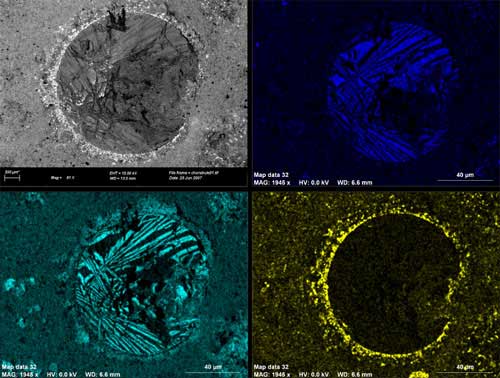
Above we have a chondrule from (TBA). The three other images are elemental maps of Aluminum (blue), Magnesium (turquoise), and Sulfur (yellow). From these maps we can clearly see how the chondrule is composed, and of what elements.
Energy-Dispersive Spectroscopy (EDS) allows easy elemental analysis of geological objects. Both of the SEM’s in the MIF are equipped with a Bruker Quantax™ Quad. The Quantax™ Quad features the unique XFlash® Quad detector -- the first four-channel 40 mm2 Silicon Drift Detector (SDD) for Energy-Dispersive Spectroscopy (EDS) systems mounted on electron microscopes. Powered by Esprit™ software, the Quantax Quad delivers significantly faster EDS results across a broad range of applications. It is especially suitable for field emission scanning electron microscopes, environmental and low vacuum scanning electron microscopes. The new high-end XFlash Quad detector complements the existing Bruker AXS Quantax EDS product line.Four independently operating 10 mm2 SDDs with integrated anodes and FETs form the heart of the XFlash Quad detector. This arrangement provides the high energy resolution of a single 10 mm2 crystal at four times the count rate, accepting maximum input count rates in excess of 2,000,000 cps.
For more information about the Bruker Quantax™ Quad, please visit their website. Denton Ebel is an Assistant Curator at AMNH in Earth and Plantary Sciences.